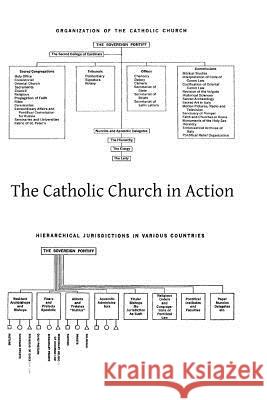The Catholic Church in Action » książka
The Catholic Church in Action
ISBN-13: 9781484044773 / Angielski / Miękka / 2013 / 368 str.
IN THIS book an attempt is made to describe briefly and accurately the main outlines of the organized system by means of which the Catholic Church carries on its work in the world today. Only the most elementary summary of this tremendous subject is possible within the limits of a single volume, not meant for ecclesiastical students, but for the average reader, whether Catholic or non-Catholic, who would like to know in a general way how the Church is constructed and how its various parts are put together to function within the framework of the institution as a whole. There are a multitude of works, ranging from the most profound theological, historical, and scientific studies of the universal Church, or of its various parts, down to the most elementary pamphlets, but so far as we know, there is no other book in English which provides the average reader with a non-controversial, general account of the whole subject. It is a non-controversial account in the sense that its authors (or perhaps its compilers would be the more accurate designation) make no effort to prove or to defend the fundamental, spiritual, moral, and intellectual teachings of the Church. These teachings are simply stated, or reported, when and where their statement is necessary for the reader to grasp the meaning, the purpose, . the end of the operations of the Church as an entity, or of any particular department of its intricate organization. There are at least two good reasons for believing that a book like this is likely to be useful today and in the years immediately ahead of us. There is, first of all, the interest created by the steadily increasing activities of the Catholic Church throughout the world and, secondly, the still more important fact that the effects and consequences of these activities are not confined to the avowed members of the Church, but are also affecting profoundly the whole human society of which Catholics form a comparatively small minority, yet a highly important one because of the social consequences of their beliefs as taught and controlled by a worldwide, centralized organization, by far the oldest and most deeply rooted of all human institutions. That the Catholic Church is, to say the least, certainly one of the major forces of the world-even if it only represents, as its enemies believe, a declining and baseless superstition-is generally admitted. Its own claim, of course, is that it is incomparably, uniquely, the supreme spiritual power in all the world. As we have already stated, it is not the purpose of this book to argue for the truth of this claim. Yet in order to make comprehensible even an outline sketch of the mechanism by means of which the Catholic Church attempts to realize this claim, it is necessary to give a brief definition of what is meant by the term, "the Catholic Church in Action." Upon that definition each and every item of the multitudinous activities of the Catholic Church absolutely depends for justification by the believers in the Church, and for correct understanding by others. First of all, then, by the term "the Catholic Church" we mean that visible society, real, one, and actively at work in the world today, which was established by Jesus Christ nineteen hundred and thirty-four years ago. Furthermore, we mean that visible society, real, one, and clearly present before the world today, which is in communion with the Apostolic See of Rome, and which accepts not only the supremacy of that See, but also the infallibility of its occupant, the Pope, when, as shepherd and teacher of all the faithful, he defines a matter of faith or morals.
Zawartość książki może nie spełniać oczekiwań – reklamacje nie obejmują treści, która mogła nie być redakcyjnie ani merytorycznie opracowana.











